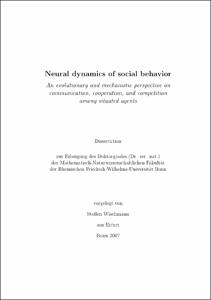Neural dynamics of social behaviorAn evolutionary and mechanistic perspective on communication, cooperation, and competition among situated agents

An evolutionary and mechanistic perspective on communication, cooperation, and competition among situated agents

| dc.contributor.advisor | Pasemann, Frank | |
| dc.contributor.author | Wischmann, Steffen | |
| dc.date.accessioned | 2020-04-12T15:05:37Z | |
| dc.date.available | 2020-04-12T15:05:37Z | |
| dc.date.issued | 2008 | |
| dc.identifier.uri | https://hdl.handle.net/20.500.11811/3625 | |
| dc.description.abstract | Social behavior can be found on almost every level of life, ranging from microorganisms to human societies. However, explaining the evolutionary emergence of cooperation, communication, or competition still challenges modern biology. The most common approaches to this problem are based on game-theoretic models. The problem is that these models often assume fixed and limited rules and actions that individual agents can choose from, which excludes the dynamical nature of the mechanisms that underlie the behavior of living systems. So far, there exists a lack of convincing modeling approaches to investigate the emergence of social behavior from a mechanistic and evolutionary perspective. | en |
| dc.language.iso | eng | |
| dc.rights | In Copyright | |
| dc.rights.uri | http://rightsstatements.org/vocab/InC/1.0/ | |
| dc.subject | Kooperation | |
| dc.subject | Kommunikation | |
| dc.subject | Evolution | |
| dc.subject | Rekurrente Neuronale Netze | |
| dc.subject | Evolutionäre Robotik | |
| dc.subject | Neurodynamiken | |
| dc.subject | Cooperation | |
| dc.subject | Communication | |
| dc.subject | Recurrent Neural Networks | |
| dc.subject | Evolutionary Robotics | |
| dc.subject | Neurodynamics | |
| dc.subject.ddc | 004 Informatik | |
| dc.title | Neural dynamics of social behavior | |
| dc.title.alternative | An evolutionary and mechanistic perspective on communication, cooperation, and competition among situated agents | |
| dc.type | Dissertation oder Habilitation | |
| dc.publisher.name | Universitäts- und Landesbibliothek Bonn | |
| dc.publisher.location | Bonn | |
| dc.rights.accessRights | openAccess | |
| dc.identifier.urn | https://nbn-resolving.org/urn:nbn:de:hbz:5N-14514 | |
| ulbbn.pubtype | Erstveröffentlichung | |
| ulbbnediss.affiliation.name | Rheinische Friedrich-Wilhelms-Universität Bonn | |
| ulbbnediss.affiliation.location | Bonn | |
| ulbbnediss.thesis.level | Dissertation | |
| ulbbnediss.dissID | 1451 | |
| ulbbnediss.date.accepted | 21.12.2007 | |
| ulbbnediss.fakultaet | Mathematisch-Naturwissenschaftliche Fakultät | |
| dc.contributor.coReferee | Alt, Wolfgang |
Files in this item
This item appears in the following Collection(s)
-
E-Dissertationen (4162)




